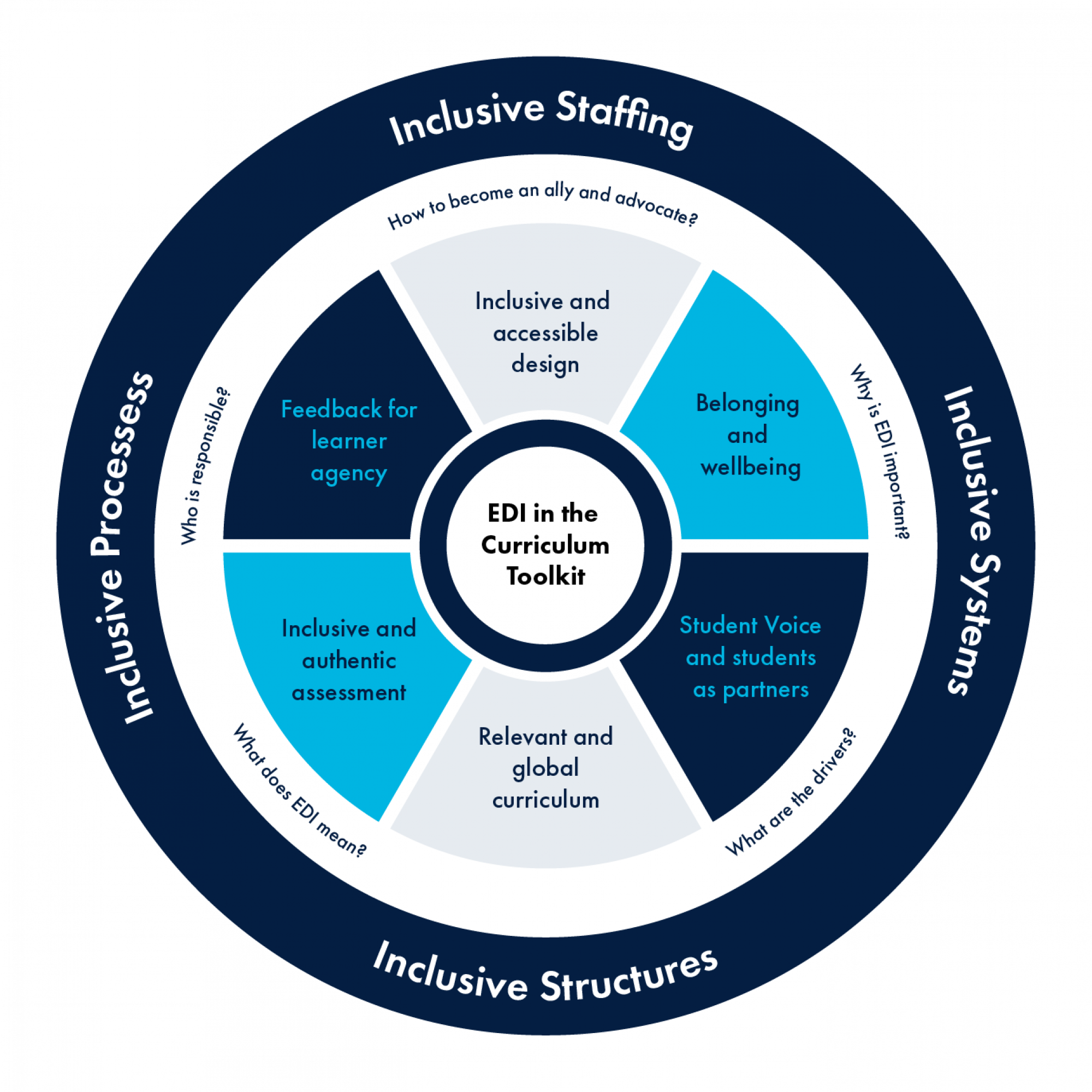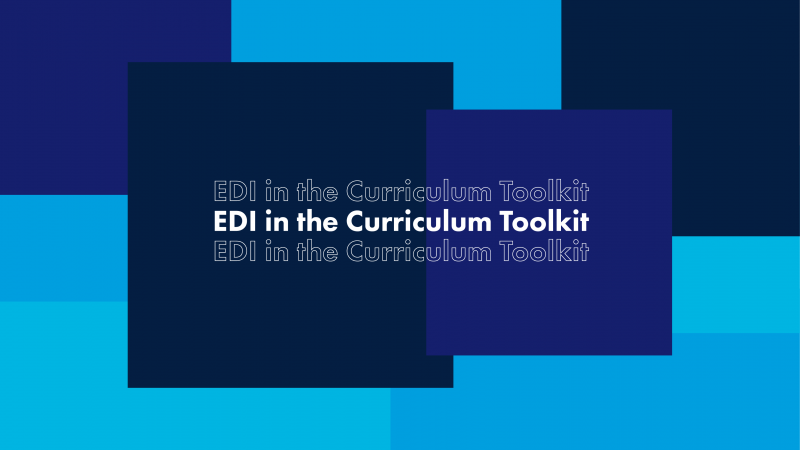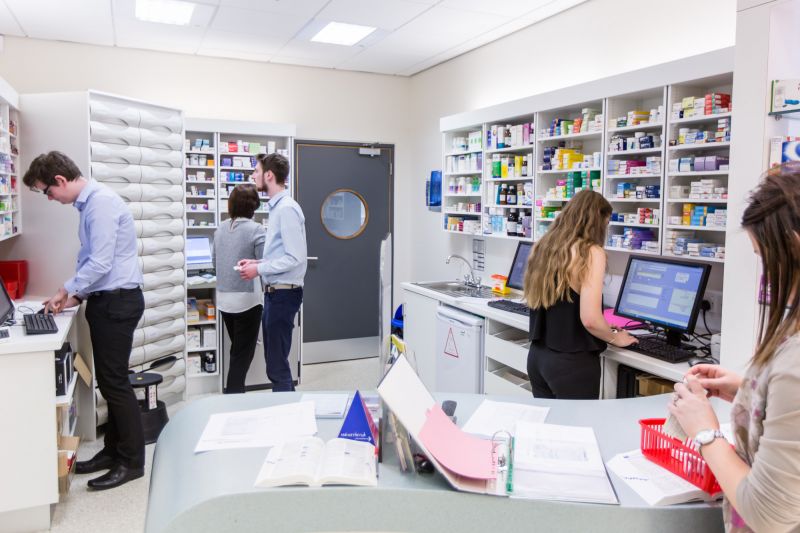Page content
Through our People, Place and Partnership Strategy, the University is committed to EDI by "taking proactive stances on equality, diversity, and inclusion: because togetherness and partnership enrich us and our work”, as well as being compliant with Section 75 of the Northern Ireland Act 1998.
More information
The EDI in the Curriculum Toolkit was developed by the Learning Enhancement Directorate led Inclusive and Accessible Curriculum and Assessment workstream.
The Toolkit was developed to support Ulster staff, and our FE partners to reflect at a modular level to further build on their inclusive practices by considering learning design, teaching, and assessment through an EDI lens.

The EDI in the Curriculum Toolkit is underpinned by socially just and critical pedagogies, universal design for learning and trauma informed pedagogies. The Toolkit consists of six pillars core to learning, teaching and assessment. Each pillar includes some ideas where initially you will identify inclusive practices that you have already embedded. You will also be supported to identify where you can make small changes to your practice over time, as well as some other practices that may require longer-term planning.
The EDI Toolkit encourages staff to critically reflect on their learning and teaching practice through an EDI lens.
EDI Toolkit Structure

The Toolkit is a move away from a one size fits all approach by maximising learning and minimising barriers. It recognises and celebrates learner variability and incorporates flexibility in the ways learners access material, how they engage with their learning and how they demonstrate their knowledge.
The Toolkit is in alignment with the wider institutional EDI commitments, graduate attributes and the University values. There is also a strong alignment with the EDI@UU programme offered to all enrolled Ulster students. Staff can access further support for embedding EDI in their learning and teaching practice by contacting the Learning Enhancement Directorate staff below:
Tracy Galvin, Lecturer in Higher Education Practice
Six EDI Toolkit Pillars

Learners to experience equitable access to learning materials.
Digital accessibility
- Consider learner variability (age, gender, disability, culture, language, and ability etc.) and level of study to offer a wide variety of accessible digital content and materials (videos, presentations, text and visuals).
- Provide accessible digital content to comply with the PSBAR (Public Sector Bodies Accessibility Regulations, 2018) and the most recent WCAG (Web Content Accessibility Guidelines) by including elements such as:
- Alternative text (alt text) for all images, infographics, diagrams etc.
- Apply styles or tagging to assign different levels to text content (e.g., title, subtitle, heading 1, etc.). This will support both readability and navigation.
- Left justify text and use a sans serif font (e.g. Aptos, Arial, Verdana, Segoe UI or Tahoma)
- Use clear colour contrasts to support readability and which have high contrasts between background and foreground. Use contrast ratio checker tools to help you with this.
- Include captions on videos, and provide transcripts for podcasts. Check auto-captions within Panopto and YouTube etc.
- Use built-in accessibility checkers within software like Microsoft and Adobe to check before saving, exporting and sharing.
- Use BlackBoard Ally within Ultra to check and address accessibility issues within your module area in the VLE.
- Consider including accessibility as part of the assessment criteria if asking learners to produce digital content.
Choice, support and engagement
- Scaffold learning and minimise barriers to understanding by highlighting key concepts, providing clear instructions and by chunking learning materials. If possible, post any learning materials for a session at least 48 hours in advance in an editable/modifiable format (e.g. Word/PowerPoint) rather than a PDF.
- Provide a variety of learner engagement opportunities in both synchronous and asynchronous activities through multiple modalities, options and choice for content and materials.
- Include a Glossary of Terms for unfamiliar and complex terms or include an option for learners to request additions through e.g. wikis.
- Provide different methods for learners to engage e.g., allow learners to interact using their camera/microphone, microphone only, or text chat in live synchronous sessions.
- Consider options for learners to post to discussion forums, interactive walls like Padlet, or use email, Blackboard, or Microsoft Teams to communicate asynchronously.
- Provide options where learners demonstrate their knowledge through different modalities e.g. poster, wiki, essay, MCQ, presentation, portfolios, blog posts, report, simulations and games, policy paper, visual media, research proposals etc.
- Offer learners, where possible, a blend of on campus and online learning with a range of activities and flipped learning approaches.
- Consider active and collaborative group work where different groups and communities collaborate and learn from one another’s lived experiences and cultures.
- Engage students as curriculum co-creators, providing opportunities for gathering students’ insights and suggestions about current and planned programme designs.
Promote Allyship
- Self-reflect on how your positionality, power and privilege may influence the design of materials, activities, and assessment.
- Promote allyship by adding staff pronouns (he/him, she/her, they/them) to email signatures and hyperlink a name pronunciation.
- Incorporate diverse identities and experiences that are relevant and authentic into materials, activities, and exemplars.
- Consider the impact of your identity beliefs, cultural assumptions, and unconscious biases as part of the design process or consider further development or training opportunities across Ulster University or externally.
- Use Pronounce name in Blackboard to avoid, (Pronounciation in Blackboard)

Learners are encouraged to engage in diverse groups to celebrate diversity and support their wellbeing to feel that they belong.
For detailed guidance, refer to the Embedding Wellbeing in the Curriculum resources.
Environment
- Equitable learning environments where all learners can access content and spaces.
- A safe, valued, and respected environment.
- Supportive social interactions among learners to learn from different perspectives.
- Supportive environment around trust, mutual respect, support, and cooperative intent.
People
- Purposeful discussion and dialogue to foster meaningful relationships, wellbeing and sense of belonging.
- Social, emotional, and cultural connections to incorporate collaborative and engaging activities.
- Sense of belonging by valuing everyone's opinion, different perspectives and lived experiences.
- Trust, consistency, and opportunities to get to know learners.
- Be cognisant of how religious, faith and cultural celebrations may be experienced differently by others.
- Diverse learning groups to have a mix of demographic characteristics to provide opportunities to get to know one another.
- Responsible mentorship and leadership and role modelling around building communities and belonging.
- Be mindfully aware of potential early life adversities which could have fluctuated affect on executive functioning skills and abilities (planning, organising, time management, concentration and memory).
- Resist re-traumatisation and relieve stress reactions by being cognisant of the potential triggers of students who have experienced a past trauma when discussing sensitive topics.
Task
- Build a sense of belonging by creating inclusive, welcoming learning environments by delivering inductions, fostering collaboration, co-creating community values, and recognising the diverse lived experiences of all students.
- Deepen the learning focus by clarifying the purpose and expectations of learning and assessment tasks, providing transparent guidance, and using formative feedback and compassionate approaches to support student understanding.
- Plan scaffolds to support student success during key transitions by deconstructing assessments, using supportive tools, and regularly signposting relevant academic and wellbeing services.
- Support students to get back on track by identifying and addressing disengagement promptly using adaptable re-engagement techniques, active listening, compassionate communication, and responding to students with empathy, respect, and understanding.
- Establish and maintain boundaries by setting clear expectations for availability, promoting respectful group interaction, addressing conflict constructively, and modelling healthy professional boundaries.
- Prioritise your wellbeing with rest and reflection, seek support when needed, and engage in ongoing professional development to sustain personal wellbeing.

Learners experience involvement in the shaping of their learning, through co-design and learner voice.
People
- Support all learners in the development of graduate attributes; thriving individuals, collaborate professionals, engaged learners and active citizens.
- Empower learners to take responsibility for their own learning through scaffolding in collaboration with their peers, acting as partners in the learning experience, to support the development of the student voice.
- Support learners to develop executive functioning skills, self-regulation and problem-solving skills to (i) minimise learning barriers, (ii) build confidence and (iii) enhance wellbeing (all of which form part of trauma informed approaches as well as building belonging e.g. in groupwork activities).
- Consider the learners’ cultural awareness and identities; include options for open dialogue, case study exemplars and activities.
- Promote self-reflection among learners on how the intersectionality of their identities influences their learning.
Context - Environment
- Promote an inclusive culture by getting to know your learners that includes knowing their pronouns and correct pronunciation of names.
- Consider unconscious and implicit biases that might exist and develop learning opportunities for all.
- Embed learner agency and learner voice as a core part of the planning, design and delivery of the module, as well as assessment types, where appropriate.
- Embed both formal and informal learning opportunities to engage learners across different contexts.
Actions - Task
- Empower learners to co-design and be content developers to support their learning and develop digital skills and outputs.
- Draw from prior knowledge and lived experiences, respect different cultures and identities.
- Ensure scaffolded and guided learning as well as independent learning and self-study.
- Set clear and challenging goals and offer learners choice in how to engage with content, co-construct rubrics and materials and experience assessment choice.
- Challenge and support learners through content/activities by providing opportunities to develop skills.
- Provide opportunities for learners to work collaboratively in diverse and mixed groups.

Learners thrive from a future-focused curriculum, designed around active citizenship, responsible leadership and genuine collaborations that goes beyond national borders.
Environment
- An educational environment in which learners feel empowered to identify instances of racism, ableism, sexism, homophobia, transphobia etc for the betterment of the learners and institution.
- Your teaching materials to reflect the diversity and variability of learners and the discipline.
- Diverse and accessible resource list, including open access resources and those with authorship or origin from the Global South, as well as representation from scholars from oppressed backgrounds.
- Open Educational Resources (OERs) and share the material through Creative Commons Licences, as well as encourage learners to develop and share their work, where relevant.
People
- The curriculum to the UN's Sustainable Development Goals (SDGs) so learners can see their role as meaningful and intentional change agents and active citizens at a global scale.
- Co-design authentic and positive teaching materials and approaches with learners and those from wider interested parties.
- Global learners who come from adversity and create awareness, respect and support, embracing non-judgemental trauma informed approaches.
Task
- Inclusive and diverse experiences and histories into the curriculum and encourage anti-discriminatory behaviour.
- Space for learners to share the diversity of their lived experiences as related to the curriculum.
- Expose learners to different perspectives from different communities, cultures and backgrounds, especially those seen as non-dominant, so everyone can experience respectful representation.
- Themes of EDI across services, processes, policies, resources, academic practice, and training.

Inclusive assessment ensures students have equal opportunities to demonstrate the full extent of their knowledge and skills across a diverse range of assessed activities. An inclusive approach also reduces the need to make individual adjustments.
Authentic assessments are tasks which are designed to reflect real-world activities, themes or scenarios, allowing students to apply their learning to meaningful contexts. Learners experience a choice and a range of assessment types across a programme to develop a range of employability skills and key competencies. Please refer to Ulster's Assessment Code of Practice for more information about assessment quality enhancement, policy, and procedures.
Student workload and expectations
- Consider learner workload and expectations of others; ensure a joined-up approach with other module leads on assessment deadlines to avoid bunching and unnecessary pressure. A joined-up approach to assessment design ensures key knowledge and skills can be mastered over time and across modules.
- Set clear and high expectations where learners demonstrate their knowledge and understanding.
- Include a choice of assessment types to accommodate learner variability without lowering academic standards e.g. reflective journals, group projects, posters, case studies, presentations and simulations, lab work, essays etc.
- Be clear with use academic language and be sure students understand academic terminology. Avoid using idiomatic language which may not be understood across different cultures. Use Plain English for student facing communications, which is clear and concise.
- Ensure learners understand how they will be assessed and what is required of them against the set criteria. Provide clear assessment briefs and marking criteria in a variety of formats. Provide opportunities for students to explore and discuss these criteria and self-assess to check their progress. Teach students to apply marking criteria to their own work or a model answer in a formative way.
Assessment design
- Review learning outcomes and the assessment task(s) to check they are achievable by all students. While individual accommodations can be made, there is scope to redesign an assessment to make it inclusive for all from the outset e.g., providing a choice of options.
- Embed flexible design using scaffolds, formative knowledge checks and modelling techniques to increase the opportunities to succeed. Provide diverse learning activities that provide multiple means of learner engagement.
- Anticipatereasonable adjustments for disabled and neurodivergent learners: consider at the design phase what can minimise barriers to demonstration of knowledge and skills.
- Design assessment through real life examples that build key competencies and employability skills within meaningful and relevant contexts. Engage with employer partners at the point of design to identify real-life learning contexts and the competencies to be developed.
- Allow some form of individuality to allow learners to demonstrate their knowledge to include both summative and formative methods. Students should be able to demonstrate a breadth of knowledge and skills through diverse assessment practices.
- Include graphic organisers, exemplars, and rubrics where appropriate to support learner progression.
- Empower learners by engaging in co-design and providing assessment choice.
- Embed a range of assessment methods that are accessible, non-discriminatory, and timely. Provide low or no-stakes formative opportunities to help students receive and apply feedback and feedforward.
- Ensure assessment design reflects a global, multicultural perspective on the subject matter and celebrates linguistic and cultural needs and preferences.
- For group assessments, encourage the cohort to negotiate group-work protocols to address role allocations, communication methods, conflict resolution and inclusivity. Support should be offered to integrate all group members.
Assessment support
- Formative opportunities should be timely to enable students to receive and act on feedback before a final summative submission. Access to support should be clearly signposted throughout the module e.g., tutorials, workshops, Studiosity, Student Success Centre, Study Advisors.
- Encourage learners to sustain effort, interest, and motivation by engaging with diverse content, materials, and activities, both individually and collaboratively through group work. Demonstrate the relevance of learning activities, their alignment with assessment and how knowledge and skills are developed by engaging in formative and summative activities.
- Develop and scaffold assessment literacy through engagement, support, and learner progression. Explain the purpose of an assessment and the rationale behind its design. Allow time in the curriculum for students to explore, discuss and understand assessment standards and criteria. Engage in discussions with students around assessment and identify learner needs e.g., referencing, academic writing, maths support. Encourage student reflection on previous performance, their particular strengths, development needs and study plans.
- Ensure the choice of technology required for assessment is digitally accessible and can be used with assistive technologies.
- Consider including accessibility as part of the assessment criteria if asking learners to produce digital content.

Learners are provided with diverse, clear and personal feedback that fosters their growth and independence but also feedforward where learners take ownership of their learning.
Preparing for Feedback
- Provide clear course navigation, clear expectations and time estimates for when learners can expect to receive feedback on their work and what they are expected to do with it; making explicit connections to prior learning which should include check-ins throughout the term to have open dialogue around challenges and issues learners face.
- Provide accessible and clear explanations of feedback processes and information about who is responsible for these processes.
- Make learners aware of different strategies, actions and changes that are required to support their learning i.e. avoid colloquialisms, acronyms and nuanced language but instead be explicit as to what the learner needs to know to improve.
- Build in opportunities for self-regulation and self-directed learning so learners can manage and enhance learner progression.
- Include formative assessments where some completed work that does not require a grade so learners can focus on a deeper engagement with the feedback provided i.e. feedforward by highlighting actionable ways of future areas of focus to improve and to build a deeper awareness.
Giving Feedback
- Ensure across a programme there is a discussion around consistency e.g. tone of language, areas how to improve, agreed range of feedback word count, colour coding, or comments provided.
- Adhere to all relevant ethical standards and procedures when processing learner feedback and communicating outcomes to learners.
- Provide a clear, consistent and compassionate response and guidance when a learner has not passed or sufficiently completed an assessed piece of work, outlining next steps and supports available.
- Ensure when using digital tools, to assist with feedback processes, that they are accessible to all and conform to GDPR, and that standardised feedback also has a personalised individual element.
- Give learners their choice of feedback method where possible (e.g., writing, by creating a video, audio file, ePortfolio or responding with comments within the submission or to discussion posts or creating digital sketch-notes etc.).
Returning Feedback
- Process feedback within agreed timeframes and share outcomes emerging from this activity at a time which will benefit learners.
- Encourage respectful and open-ended dialogue between staff and learners to ensure feedback cycles are dynamic and inclusive.
- Include learner scaffolding to support self and peer review feedback practices around using positive language and critical reflection e.g. promoting self-awareness byasking learners to recap the main points orwrite up an action plan based on the feedback.
- Provide opportunities to discuss feedback both formally in class and live sessions for generic feedback, as well as informally.
- Ensure achievements emerging from actions taken because of learner feedback are shared and discussed with learners.
- Review and evaluate learner feedback with a view to supporting continuous improvement.
EDI in the Curriculum Toolkit, Learning Enhancement Directorate, Ulster University (2025), This work is licensed under CC BY 4.0

















